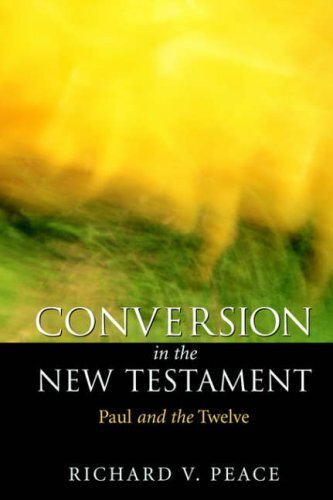Richard Peace, Conversion in the New Testament: Paul and the Twelve. Eerdmans, 1999.
Referenced in: Theology and Practice of Evangelism – Missionally Responsive/Evangelical
LifeandLeadership.com Summary
This is an excellent discussion of the process of conversion, and is a useful text for evangelism. Understanding conversion helps the evangelist participate in God’s movement in another’s life.
The rubric Peace uses to discuss “normative conversion” is the process as it worked in the lives of the apostle Paul and the twelve. First, he provides a careful, reasoned critique of “event” or “encounter” evangelism as manifested in Paul’s Damascus Road experience. Paul’s was a sudden, point-in-time transformation based on an encounter with Jesus. This “accept Jesus now” model has been the focus of most conversion efforts among evangelicals. But it has come under severe criticism by biblical scholars who regard Paul’s experience more as a unique “call,” not a conversion. Peace argues that the encounter is indeed one legitimate model of conversion, though not without caveats as it is commonly practiced in evangelical circles.
Peace finds in Paul’s experience a three-component core pattern to this conversion:
- Repentance, which is preceded by insight into one’s true state before God
- Turning to God and away from the world or Satan, as reflected in the biblical word, conversion (Gk. epistrophe)
- Transformation, the change of life that flowed from Pau’s response to Jesus, as seen in one’s deeds. (27)
He devotes a chapter to each of these components, drawing from the book of Acts and the letters of Paul.
Interestingly, Peace proposes the core theological understanding of true conversion is identical in the experiences of both Paul and the twelve, even though it occurred in different ways. Thus, the next part of the book chronicles the conversion of the twelve.
Peace calls the path of the Twelve “process evangelism” or spiritual pilgrimage. He sees this played out in the Gospel of Mark, even so far as to say that the conversion of the twelve is the organizing principle of Mark. The major component of this conversion was their increasing recognition and understanding of the identity of Jesus.
What Mark sought to communicate in is Gospel was the process by which these twelve men gradually turned, over time, from their culturally derived understanding of Jesus as a great teacher to the amazing discovery that he was actually the Messiah who was the Son of God. In this showing how the Twelve turned to Jesus, step-by-step, Mark was inviting his readers to undergo the same journey of conversion. (4)
This is a fascinating look at this biblical book and at the nature of conversion. He outlines Mark’s Gospel so as to reflect the six-part movement of the Twelve in their unfolding understanding of who Jesus is.
The last part of the book, chapters 11-13, discuss how understanding these two paradigms for conversion have implications for the church’s ministry of evangelism. This includes a careful appropriation of encounter evangelism and a model for process evangelism. He offers practical insight into how small groups, spiritual disciplines, and worship contribute to the conversion process.
This material is the fruit of Peace’s Ph.D. dissertation, a work that took over twenty years of research and observation. It is a very responsibly researched work, reflecting deep awareness of scholarship on spiritual formation, evangelism, and biblical studies.
From the Publisher
This inspiring look at conversion in the Bible offers promising new changes in the way we view—and do—evangelism today.
In order to be effective in evangelism, one must clearly understand the dynamics of conversion. Richard Peace here examines two very different conversion experiences—Paul’s and the twelve disciples’—and explains their implications for contemporary evangelism. By showing how conversion can take place either suddenly or gradually over time, Peace gives good reasons, and suggests practical ways, to replace one-sided evangelism techniques with more wholistic methods.
About the Author
Dr. Richard Peace is the Robert Boyd Munger Professor of Evangelism and Spiritual Formation at Fuller Theological Seminary in Pasadena, California and is an ordained minister in the United Church of Christ. Dr. Peace has over a hundred and fifty titles to his credit including Learning to Love trilogy of Bible studies.
***For additional information on this resource, including reviews, click the bookstore links. Check the reference at page top or the links below for resource guides on related topics.***
Related Areas
See Other Resources on Evangelism:
See Resources on Over 100 Areas of Ministry Leadership:


